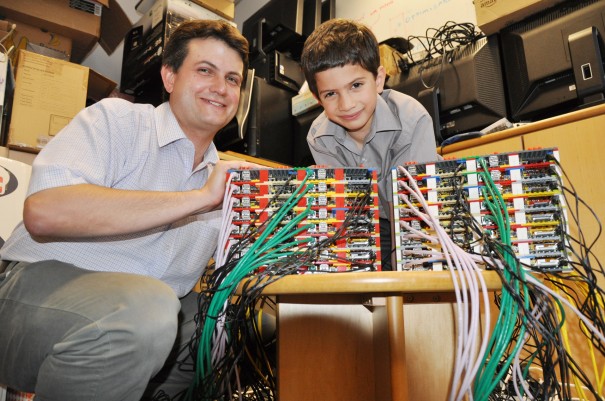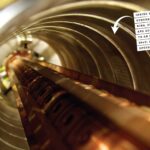
Professor Simon Cox and his Lego-expert son James with Iridis-Pi, the supercomputer made from Raspberry Pi and Lego blocks. Image: Simon Cox
Father and son developed a step-by-step guide on how to make your own supercomputer.
Raspberry Pi computers retail for around $25 and include a 700MHz ARM11 processor and 256MB of SDRAM on a board the size of a credit card. Professor Simon Cox of the University of Southampton and his Lego-expert son James decided to built a supercomputer of sorts using 64 Raspberry Pi units and Lego blocks
“We were interested in how the price to get a system has gone from millions of dollars through hundreds of thousands to tens of thousands and now down to thousands of dollars, and that with Raspberry Pi you can really show parallel programming in the raw at the thousands dollar price point,” Cox says. “Indeed, using 4 Raspberry Pi computers which would show the essential principles would get this figure down to the hundreds of dollars price point. That means that it is accessible to schools and so brings a whole new generation that can be inspired and enabled to get into computational science and engineering.”
Each Raspberry Pi has a 16-gigabyte SD card for about 1 TB of combined disk space. It all runs off a single 13 A power supply. The total cost (not including the Ethernet switches) was about $4,000. In their step-by-step guide about the computer, which they call Iridis-Pi, Cox explains that first they ran a test and calculated Pi on the Raspberry Pi using MPI (message passing interface), which is a well-known first test for any new supercomputer.
Cox notes that calling it a “supercomputer” is an exaggeration. It is a parallel computer with processing power similar to old supercomputers, rather than current ones. Keeping in mind that the Raspberry Pi was originally developed with the intention of stimulating the teaching of basic computer science in schools, it is still a great tool to use when first familiarising oneself with the basics of computer programming.
Cox adds that his six-year-old son has been very excited by the programming software Scratch and Python, and by being able to change a program to make a computer do simple things on screen such as control animated characters or control electronics externally.
“He was really excited when he realised that underneath the applications and games that he uses on computers is code, and when you change it you can make the computer do entirely different things!” Cox says. “For example, we wrote a very simple little program for showing (and testing) times tables and we could change it to make the output on the screen look exactly how he wanted it. Getting confidence through small steps is an important part of the educational process. As is having fun!”
You can learn to make your own Raspberry Pi Supercomputer by visiting this site.






